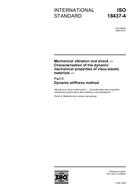We need your consent to use the individual data so that you can see information about your interests, among other things. Click "OK" to give your consent.

ISO 18437-4:2008
Mechanical vibration and shock — Characterization of the dynamic mechanical properties of visco-elastic materials — Part 4: Dynamic stiffness method
Automatically translated name:
Mechanical vibration and shock -- Characterization of the dynamic mechanical properties of visco-elastic materials -- Part 4: Dynamic stiffness method
STANDARD published on 20.5.2008
The information about the standard:
Designation standards: ISO 18437-4:2008
Publication date standards: 20.5.2008
SKU: NS-428143
The number of pages: 20
Approximate weight : 60 g (0.13 lbs)
Country: International technical standard
Category: Technical standards ISO
The category - similar standards:
Annotation of standard text ISO 18437-4:2008 :
Description / Abstract: ISO 18437-4:2008 specifies a direct method for measuring the complex dynamic moduli of elasticity (the Young, shear and bulk moduli, and their respective loss factors corresponding to the tensile, shear and all compressive strains) for polymeric (rubbery and viscous polymers, as well as rigid plastics) materials over a wide frequency and temperature range. Measurements are performed by the dynamic stiffness method, which uses electric signals from sensors attached to a test piece. These signals are proportional to the dynamic forces acting on the test piece and the strains in the test piece due to the effect of these forces. The measurement frequency range is determined by the size of test piece, the accuracy required on the dynamic modulus measurements, the relationship between the stiffness of the oscillation generator and the stiffness of the test piece, and by the resonance characteristics of the test fixture used. The method presented in ISO 18437-4:2008 allows measurement under any static pre-load allowed for the test piece (including the test piece having the non-linear characteristics under different static loads), but under small dynamic (acoustic) strains, i.e. in limits where the linear properties of the test piece are not distorted. Depending on the pre-load conditions, the relation between the moduli is unique.
We recommend:
Updating of laws
Do you want to be sure about the validity of used regulations?
We offer you a solution so that you could use valid and updated legislative regulations.
Would you like to get more information? Look at this page.



 Cookies
Cookies
